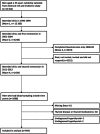Changes in thyroid function and evolution of subclinical thyroid disease in older men
- PMID: 38059618
- PMCID: PMC10952793
- DOI: 10.1111/cen.14997
Changes in thyroid function and evolution of subclinical thyroid disease in older men
Abstract
Objective: Prevalence of subclinical thyroid disease increases with age, but optimal detection and surveillance strategies remain unclear particularly for older men. We aimed to assess thyroid stimulating hormone (TSH) and free thyroxine (FT4) concentrations and their longitudinal changes, to determine the prevalence and incidence of subclinical thyroid dysfunction in older men.
Design, participants and measurements: Longitudinal study of 994 community-dwelling men aged ≥70 years without known or current thyroid disease, with TSH and FT4 concentrations assessed at baseline and follow-up (after 8.7 ± 0.9 years). Factors associated with incident subclinical thyroid dysfunction were examined by logistic regression and receiver operating characteristic analyses.
Results: At baseline, 85 men (8.6%) had subclinical hypothyroidism and 10 (1.0%) subclinical hyperthyroidism. Among 899 men euthyroid at baseline (mean age 75.0 ± 3.0 years), 713 (79.3%) remained euthyroid, 180 (20.0%) developed subclinical/overt hypothyroidism, and 6 (0.7%) subclinical/overt hyperthyroidism. Change in TSH correlated with baseline TSH (r = .16, p < .05). Change in FT4 correlated inversely with baseline FT4 (r = -0.35, p < .05). Only higher age and baseline TSH predicted progression from euthyroid to subclinical/overt hypothyroidism (fully-adjusted odds ratio [OR] per year=1.09, 95% confidence interval [CI] = 1.02-1.17, p = .006; per 2.7-fold increase in TSH OR = 65.4, CI = 31.9-134, p < .001). Baseline TSH concentration ≥2.34 mIU/L had 76% sensitivity and 77% specificity for predicting development of subclinical/overt hypothyroidism.
Conclusions: In older men TSH concentration increased over time, while FT4 concentration showed little change. Subclinical or overt hypothyroidism evolved in one fifth of initially euthyroid men, age and higher baseline TSH predicted this outcome. Increased surveillance for thyroid dysfunction may be justified in older men, especially those with high-normal TSH.
Keywords: ageing; free thyroxine; hypothyroidism; men; subclinical hyperthyroidism; subclinical hypothyroidism; thyroid-stimulating hormone.
© 2023 The Authors. Clinical Endocrinology published by John Wiley & Sons Ltd.
Conflict of interest statement
The authors declare no conflict of interest.
Figures



Similar articles
-
Subclinical thyroid dysfunction and circulating thyroid hormones are not associated with bone turnover markers or incident hip fracture in older men.Clin Endocrinol (Oxf). 2018 Jul;89(1):93-99. doi: 10.1111/cen.13615. Epub 2018 May 15. Clin Endocrinol (Oxf). 2018. PMID: 29655173
-
Reference Ranges for Thyroid-Stimulating Hormone and Free Thyroxine in Older Men: Results From the Health In Men Study.J Gerontol A Biol Sci Med Sci. 2017 Mar 1;72(3):444-449. doi: 10.1093/gerona/glw132. J Gerontol A Biol Sci Med Sci. 2017. PMID: 27440910
-
Higher free thyroxine levels are associated with all-cause mortality in euthyroid older men: the Health In Men Study.Eur J Endocrinol. 2013 Sep 12;169(4):401-8. doi: 10.1530/EJE-13-0306. Print 2013 Oct. Eur J Endocrinol. 2013. PMID: 23853210
-
Thyroid Dysfunction and Anemia: A Prospective Cohort Study and a Systematic Review.Thyroid. 2018 May;28(5):575-582. doi: 10.1089/thy.2017.0480. Epub 2018 Apr 30. Thyroid. 2018. PMID: 29631476
-
Association between maternal thyroid function and risk of gestational hypertension and pre-eclampsia: a systematic review and individual-participant data meta-analysis.Lancet Diabetes Endocrinol. 2022 Apr;10(4):243-252. doi: 10.1016/S2213-8587(22)00007-9. Epub 2022 Mar 4. Lancet Diabetes Endocrinol. 2022. PMID: 35255260 Free PMC article.
Cited by
-
Association between sensitivity to thyroid hormone indices and frailty in the elderly: a cross-sectional study.Front Endocrinol (Lausanne). 2025 Jul 3;16:1463283. doi: 10.3389/fendo.2025.1463283. eCollection 2025. Front Endocrinol (Lausanne). 2025. PMID: 40678317 Free PMC article.
-
Management Aspects of Medical Therapy in Graves Disease.Endocr Pract. 2025 Apr;31(4):536-546. doi: 10.1016/j.eprac.2024.12.012. Epub 2024 Dec 17. Endocr Pract. 2025. PMID: 39701285 Free PMC article. Review.
References
-
- Wilson S, Parle JV, Roberts LM, et al. Prevalence of subclinical thyroid dysfunction and its relation to socioeconomic deprivation in the elderly: a community‐based cross‐sectional survey. J Clin Endocrinol Metab. 2006;91(12):4809‐4816. - PubMed
Publication types
MeSH terms
Substances
Grants and funding
LinkOut - more resources
Full Text Sources
Medical

